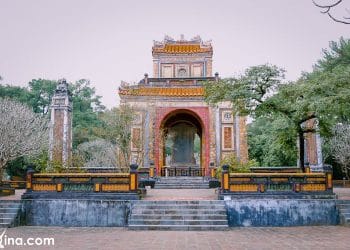The complex of monuments in Hue is famous for many unique architecture works. Among them, Nam Giao Esplanade was regarded as the remain for worshiping of Nguyen Dynasty through nearly 100 years.
Location
Nam Giao Esplanade belongs to the architectural monument complex of Nguyen Dynasty. It was built in Duong Xuan village towards the South of Hue Citadel and 5 km far away. It is now in Truong An ward, Hue City.
History
Nam Giao Esplanade was the place Nguyen Kings used to organize the ceremony of offering sacrifices to “heaven and earth” in spring. It is renowned as the largest one in Vietnamese history left. Also, Nam Giao is the only Esplanade remaining among many old ones in Hue.
Nam Giao ritual is the most prominent meaningful ceremony in the monarchy system because of the belief “King was the son of God”. Therefore, Kings themselves had the right to carry out the ritual of “Heaven and Earth” to promulgate the edicts for informing the public, bestow favour to mandarins and claim the power of the King to rule the country. As a result, almost all of the Kings in Vietnam feudal Dynasties held the rituals and gave an order to build Nam Giao esplanade.
Nam Giao Esplanade was built in 1803 under the Emperor Gia Long. After construction completion, Gia Long King first organized the rite on 27th March 1807. During the period (1807-1885), Nam Giao was always the place where Nguyen Kings chose to come to give offerings God annually in the spring. From 1886 to 1890 Hue court did not hold the ceremony. Until Thanh Thai times, the emperor realized that holding the ceremony was very costly, so from 1891, the ritual occurred every three years.
23rd March 1945 was considered the last ceremony of the Nguyen Dynasty. As a whole, there were 10 in 13 Kings holding the ritual in Nam Giao Esplanade with 98 ceremonies. Until 1993 Nam Giao, Hue was in the list of 16 monuments recognized as a World Heritage by UNESCO. In 1997, Nam Giao was ranked the national history-culture monument and in restoration.
Structure

Giao Esplanade was built in the rectangle ground with the square area of 10ha. The centre of Nam Giao is Giao esplanade. Towards the south, the Esplanade includes three terraces. The first terrance, symbolizing the human, is square-shaped and red. This terrace had doors and 4-step verandas in each side.
The second terrace, called Phuong Esplanade, also square-shaped and yellow, represents the earth. Four sides of Phuong Esplanade have five-step verandas. In Nguyen Dynasty, Phuong Esplanade was used to give offerings the Sun, the Moon, stars, clouds (or called supernatural powers).
The third terrace is in the circle shape and green colour; so-called the Vien Esplanade, it is the icon of heaven. From 1846, it was called Hoang Khung Vu. Four sides of Vien Esplanade have the porches, the southern porch has 15 steps and three porches left have 9 steps. The layout obeys the principle of the Oriental Universe theory: Earth symbolizes the circle, Heaven symbolizes the square.
There are also a lot of houses and pine trees grown circling the Esplanade featuring Trai Palace where the Kings had a vegetarian diet and took a rest during the ceremonies, Than Tru (Kitchen) where to prepare animals for offering, Than Kho (Warehouse) where to store things for worshipping, and many other substructures and others.
Cultural Values
Giao ceremony is not only the most vitally important to Nguyen Kings in power declaration but also bears many features of folk beliefs and spirituality from generations to generations. Vietnam esplanades in general and Nguyen Dynasty’s Esplanade, in particular, were aimed at honoring the ancestors and wishing blessings and prosperity for the public and the country. It was realized that sacrificed things called “con sinh”, “con sanh” were fat and healthy animals like buffalos, pigs and chickens. These creatures stuck to agriculture and Vietnamese people from the ancient time, they are symbols for people’s aspirations of good living conditions without diseases or crop loss. Worshiping supernatural power such as Heaven, Earth or the sun shows the gratitude of people to God helping people, creating creatures and plants for the earth. Especially, the ceremony is also people’s belief of a brighter life where there are timely rains and favourable weather as well as peace for the country.
Sightseeing

At this historical monument of the Nguyen Dynasty, you can experience the cultural features and learn more about the rituals of Nam Giao ceremony. The architecture of Nam Giao esplanade brings exciting and curious moments for tourists. In addition, festivals of the Nam Giao ceremony were restored and performed by Hue artists from 2004. So, when you come to each Hue Festival, you can enjoy the unique spiritual atmosphere of the ceremony. The ceremony was remade with the investment of facilities, careful research of history, which makes you feel so excited as if you were a part of the ceremony in Nguyen Dynasty more than 150 years ago.
By Minh Phuong















